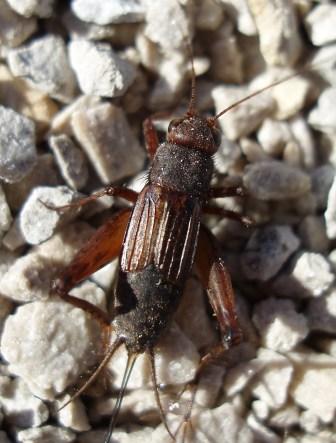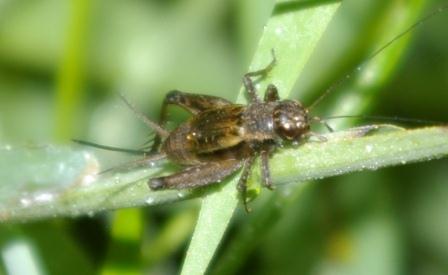by Carl Strang
There are 3 species of ground crickets that occur throughout the Chicago region (I still lack 2 county records for one of these, but expect to make up that deficit on a future Wisconsin trip). The ground crickets are the LBJ’s of singing insects (birding jargon: “little brown jobs” refers to sparrows, wrens and the like which are quick to vanish before they can be identified). Most ground crickets look identical at first glance, are tiny, and usually are brown. I’ll begin with the striped ground cricket.
This is the weediest of the ground crickets, first to show up in disturbed sites, and abundant in lawns. Its song consists of separate brief rough buzzes, continuously produced at 2 to 3 per second. It is low enough in pitch to hear easily, with most of the buzz’s sound range below 7 kHz. Here is a recording (complete with background bird songs and the usual traffic rumble):
The second species also occurs in open areas, but mainly where the grass is taller and vegetation better established.

Allard’s ground cricket is a close relative of the striped. The head stripes are absent, faint, or incomplete, however.
The song consists of incessant, separate quick very high-pitched notes (6 kHz) that sound like 4-6 per second but sonographs show twice that rate. There are fairly frequent, very brief pauses (again, birds and this time a train in the background):
Now I will toss in a fourth species. The tinkling ground cricket is less widely distributed than the others (so far I have found it in half of the region’s counties), but include it here to provide a comparison to the Allard’s song. Here is a recording:
The song consists of high pitched (7 kHz) individual notes, like those of Allard’s ground cricket but distinctly slower at a given temperature (1/3 to ½ as rapidly produced). It often is rendered “tink-tink-tink…” The song is uninterrupted, lacking the frequent breaks characteristic of Allard’s ground cricket (this is especially helpful late in the season, when Allard’s often slows down). The tinkling ground cricket lives in open woodlands and woods edges, and is especially abundant on sandy soils. It looks different, too.
The final, common species is the Carolina ground cricket.

The Carolina ground cricket has faint head stripes. The female is distinguished by an unusually short ovipositor.
Its song is a continuous, irregularly pulsed drone, purr or trill with periods when additional pitches are added to the song, making it more dissonant. Though the sound pulses are broad enough in pitch range to qualify as a drone, it is not far from a trill, and low enough in pitch to be heard by most, at 6 kHz. Here is a recording:
As the passing geese perhaps imply, Carolina ground crickets prefer moist habitats, from wetland edges to bottomland forests. In my residential neighborhood they are fairly common, but stick to the cooler, moister foundation shrub plantings against the houses.
We’ll have to wait a while to hear these crickets again. They winter in the egg form, and need until the very end of June or, more often, July to develop to the point where they begin singing.


Lisa Rainsong said,
February 25, 2014 at 11:01 pm
Carolina Ground Crickets are the most common in my area, followed by Striped and Allard’s. I would need to go to the western half of the state to hear Tinkling Ground Crickets. I’ve heard them on Kelleys Island toward the western end of Lake Erie, but they simply don’t seem to be in NE Ohio.
natureinquiries said,
February 26, 2014 at 6:42 am
From what you have told me in the past, I wonder if they are replaced by spotted ground crickets in your area. That’s a species I still haven’t found here, despite the claims of old records.